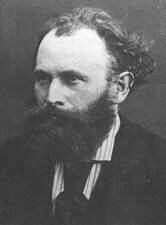 Edouard Manet23.01.1832 Paris - 30.04.1883 Paris Art history: ImpressionismCanvases of Edouard Manet [76 canvases]
Biography of Edouard ManetEdouard Manet was born on January 23, 1832 in Paris into the family of August Manet, an officer in the Ministry of Justice, and his wife Eug?nie-D?sir?e, n?e Fournier, daughter of a diplomat. His uncle, Edmond-Edouard Fournier, gave the boy his first lessons in drawing. In 1844-1848, Manet studied at the College Rollin, where he met his lifelong friend Antonin Proust. In 1848-49, he was trained as a sea cadet on a voyage to Brazil, but in April 1849 he failed his naval examinations and decided to switch to painting. He entered the studio of Thomas Couture, where he studied for 6 years, between 1850 and 1856. In 1856, he took a long travel through Europe. After traveling in Germany, Austria and Italy to study the Old Masters, Manet finally found the answer to all his questionings and aspirations for light and truth in the paintings of Velasquez and Goya at the Louvre. Influenced by these masters and by the example of Courbet, a French realist painter, he gradually evolved a new technique which presented modern aspects by modern methods. In 1861, his The Spanish Singer was accepted at the Salon and won an honorable mention. But his submissions to the Salon of 1863, The Picnic among them, were rejected and appeared at the Salon des Refus?s. The large canvas became the focus of scandalized critical and public attention. In October 28, 1863, Manet married Suzanne Leenhoff in Holland (See her portrait The Reading, on which Mme Manet is depicted being read to by L?on Ko?lla). Manet’s wife was Dutch, two years his senior, and an excellent musician. She had been employed by August Manet to give Edouard and his brother Eug?ne piano lessons. After a relationship lasting more than ten years, Manet finally married Suzanne after his father's death. L?on Ko?lla was Suzanne’s son, born in 1852. His father was almost certainly Manet, but he was presented as Suzanne’s younger brother. Manet painted L?on Ko?lla several times, the most known canvas with him is Luncheon in the Studio, on which L?on Ko?lla is the central figure. An even greater scandal than that aroused by The Picnic, was caused by Olympia, shown in 1865. The public was infuriated not only by the style, but also by the subject of the picture. ‘A yellow-bellied courtesan’, ‘a female gorilla made of india-rubber outlined in black’, ‘the Queen of Spades after her bath’, ‘a parcel of nude flesh or a bundle of laundry’, and other similar characteristics appeared in newspapers. When words were exhausted some ‘enthusiasts’ tried to finish with the picture physically, and it was saved only thanks to being hung high, above the reach of the fanatics. Although Manet was frequently in the company of members of the Impressionist group – Berthe Morisot, his sister-in-law since December 1874, Degas, and Monet in particular, and they regarded him as a leader, he had no wish to join their group. He was naturally irritated by the critics’ tendency to confuse him with Monet. Manet’s stylistic discoveries, such as ‘there are not lines in Nature’, which led to his abandoning of the conventional outline and his shaping the forms by means of color and subtle gradation of tints, decisively influenced the Impressionists, but their representation of light and optical reactions to color were different. Manet never painted what could be called a truly Impressionist picture. In 1869, Manet met Eva Gonzal?s, who became his student. During the Franco-Prussian War he joined National Guard; when in May 1871 he finally returned to Paris he found his studio partly wrecked. In 1873, his Len Bon Bock achieved considerable success at the Salon. In 1881, Manet exhibited his portraits of Henri Pertuiset and of Rochefort at the Salon, and obtained second class medal. The same year he was received into the Legion of Honor. In 1882, he exhibited for the last time at the Salon, showing Spring and Bar at the Folies-Berg?re. After a long illness, which had been exhausting him for about 5 years, he died on April 30, 1883.
You can find canvases of this artist in these museums:
|
Для красивого отображения Облака Quick Search artists |
|||||||||||||||